[This week’s Weekly includes my interview with Carlos Basualdo, new Curator of Contemporary Art and the PMA. Here’s the link. I’ll post some out-takes from the interview that didn’t make it into the Weekly in another post. And in the listings, my editor’s choice short review of the group show “Series…” at Gallery Joe. Here and here are Libby’s two posts on that show.]
Carlos’ Dream
A conversation with the PMA’s new curator of contemporary art.
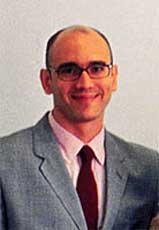
Things are changing on Museum Hill. In 2004 the Philadelphia Museum of Art began a reorganization that split the curating duties in its Department of Modern and Contemporary Art, creating two posts-a curator of modern art in Michael Taylor, and recently, a curator of contemporary art in Carlos Basualdo. Last month’s appointment of Robert Storr as consulting curator of modern and contemporary art completes the team. (image above is Basualdo in photo taken when he was co-curator of the Documenta 11)
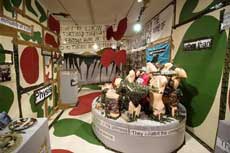
And recently the museum made a surprising purchase at Art Basel Miami Beach: Thomas Hirschhorn‘s “Camo-Outgrowth (Winter),” an installation by the Swiss-born artist of social critiques whose materials often include cardboard, tape and recycled matter. Hirschhorn’s art is unlike the cool conceptual art that appears in the PMA contemporary galleries, and its purchase signals a breakthrough to new thinking.
[Note: I couldn’t find a picture of “Camo” anywhere. But here’s a brief description of it in an article about Art Basel Miami Beach by Rachel Cooke of the Guardian. The piece’s materials include 131 school globes, tape, wood shelves and magazine images of soldiers and other people around the world in camouflage gear, or camouflage apparel. Meanwhile, above image is Hirschhorn’s installation “Utopia, Utopia=One World, One War, One Army, One Dress,”at the Boston ICA, a piece that has some of the same things on its mind — militaristic culture pervading the world. Read a review of the Boston show which just closed.]
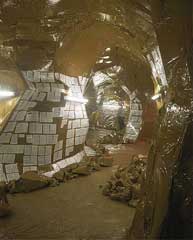
The Argentine-born Basualdo, who co-curated “Documenta11” in Kassel, Germany (and who teaches in the school of Art and Design at Universitá IVAV in Venice), shepherded the Hirschhorn purchase. (image above is from Hirschhorn’s “Cavemanman,” an installation Libby and I saw in 2002 at Gladstone Gallery in Chelsea. It was an exciting piece with weird survivalist and anti-war themes.)
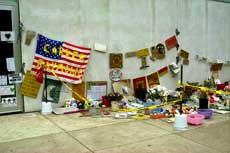
“He’s aware of the international and interested in the local,” says Paula Marincola, director of Philadelphia Exhibitions Initiatives (PEI), about Basualdo, who sat on a PEI grant review panel in 2002. “He was a really great panelist. He’s really engaged, interested in all the little-to-big things-in a generous way,” she adds.
On Feb. 8 Basualdo will moderate a symposium at Moore College in conjunction with the PEI-sponsored Artur Barrio exhibit. Basualdo was on the committee that selected Barrio for the show.
[Note: Speaking of Moore..and Hirschhorn..and Basualdo, Thomas Hirschhorn did a street altar piece, in homage to Raymond Carver, between Mar 7-26, 2001. Moore’s website has great documentation of the event. Image above is picture of the altar which was on 20th St. between Cherry and Race Sts.]
I met Basualdo in his office recently. A youthful 41, he’s thrilled to be on the PMA team. Interestingly, his office has no art on the walls.
Tell me about “Notations,” your exhibit program to rethink the contemporary collection, which begins in the spring. You said the title is from the John Cage book and exhibition by the same name.
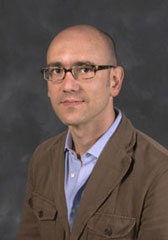
“We want to retell the story about the passage from modern to contemporary art and say how the dialogue was across cultures and boundaries. The Alter Gallery [the main contemporary gallery space] will rotate the works. It’ll be a series of shows, like writing in space, like a cartoon that goes on. By spring we’ll have the first sketch. Call it sketches. We’re trying things. People are less intimidated by sketches. In Perelman [the PMA’s new building across the Parkway, which will house several departments of the museum] there’ll also be space for us. Perelman won’t be our main focus. But there will be a place for modern and contemporary there.” (image is Basualdo in the official PMA photo)
Will Philadelphia artists be included in the sketches?
“We’re in the process of doing that. Outreach for us is very important. What we need is more walls. People think we don’t have many contemporary works, but the works in the contemporary collection number in the hundreds.”
You’re interested in video, and mentioned seeing a video animation by South African artist William Kentridge in Miami. Would you like to work with Kentridge?
“Video is a way to look very widely, and also to look at very young artists whose work won’t necessarily enter the collection. It allows us to learn from the outside. There’s fantastic video art in Kazakstan, Ramallah, Tel Aviv. That could be one of the ways of telling stories. I’d love to work with Kentridge, but I need a [funder] to make that happen.”
Your background is in literature?
“I studied medieval poetry and modern poetry. Dante, Cavalcanti, Wallace Stevens, Pound and Eliot. I always wrote poetry. I write also through my shows.”
You don’t have any art on your office walls. How come?
“These walls belong to contemporary artists. I don’t want them to come here and feel competition. I’d like to put up maps.”
Do you like Philadelphia?
“How can you not like Philadelphia? It reminds me of a European city. Many parts feel like London. It has great restaurants. It’s great for bringing up kids. I have one. He’s 1 year, 8 months. My wife, [art historian Mónica Amor], who’s one of the toughest critics, loves it here.”
sketches
“Series … ”
Through Feb. 4. Gallery Joe, 302 Arch St. 215.592.7752.
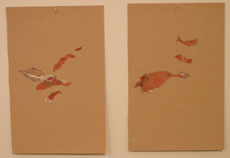
Andy Warhol knew it when he placed two Elvises on a canvas side by side. Agnes Martin did too, when she started making stripe and grid drawings. There’s something seductive about images made in series. If one is good, two is better—more satisfying on a deep psychological or biological level. “Series … ” at Gallery Joe shows works in series by nine artists. These artists don’t make Warholian repeats, although the stamp of Martin and her grids is here. The processes range from free associative drawings by Michelle Oosterbaan, and abstract cartoonlike panels in series by Douglas Florian and Sherae Rimpsey (both among my favorites in the show), to more recipelike works by Sharyn O’Mara (walk with pencil and paper in hand and draw the steps as a series of dots and lines) and Susan Tiger (catch raindrops on paper during a storm).
(image above is detail from Sherae Rimpsey‘s “Flank Fatigue-The failure to preserve or maintain #1-77.” The grid of drawings spanned an entire wall.)**
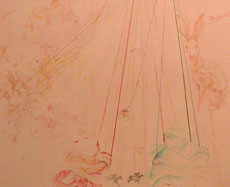
Xylor Jane‘s math-based wall drawing “Quadrant” (not shown but Libby’s posts have a pictures) made with colored marker is perhaps the work that creates the visual answer to why some artists work in series. Jane’s open, inviting, netlike form—with its bright white oculus in the middle—creates a window that might be the portal to a mystical zone, one with answers to questions like, “Why are series so appealing?”
(image is detail from Michelle Oosterbaan‘s “Rock Pool Series.” The artist has a solo show next fall with the gallery.)
**[NOTE: This post has been corrected. It previously said there were 300 drawings in the series Flank Fatigue. Sherae Rimpsey wrote to say that the “Flank Fatigue: The Failure to Preserve or Maintain” drawings are in fact the complete series. The 300 drawings that Becky Kerlin referred to are actually a different body of work – “crote forms”.]









